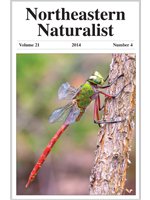While Terrapene Carolina Carolina (Eastern Box Turtle) are found over a wide geographic range, they appear to select microhabitats based on the need for thermoregulation, minimization of water loss, and reproduction. Habitat selection and the activity patterns of Eastern Box Turtles in southwestern Virginia were studied in relation to short-term weather conditions and seasonal variation. Turtles were located using telemetry 36% of the time in the interior of mature forest habitats, 23% in edge habitats, 18% in fields, 7% in a 22-year-old Pinus strobus (Eastern White Pine) plantation, 7% in forest canopy gaps, 5% in a 4-year-old clearcut, and 4% in streams. We observed a seasonal shift in habitat use, with more turtles using mature forest habitat compared to other habitat types in all months, except for May when 47% of all turtles were located in edge habitat. Also, Eastern Box Turtles often selected canopy gaps within forests during the fall, and females moved from forests to recent clearcuts during the nesting season, which accounted for a larger home-range size. As expected, turtle activity was lower during hot, dry periods in midsummer and decreased gradually during the autumn with decreasing temperature. Rainfall increased turtle activity, especially when following prolonged dry periods.
How to translate text using browser tools
1 December 2014
Thermal Regulation and Habitat use of the Eastern Box Turtle in Southwestern Virginia
Todd S. Fredericksen
ACCESS THE FULL ARTICLE

Northeastern Naturalist
Vol. 21 • No. 4
December 2014
Vol. 21 • No. 4
December 2014




